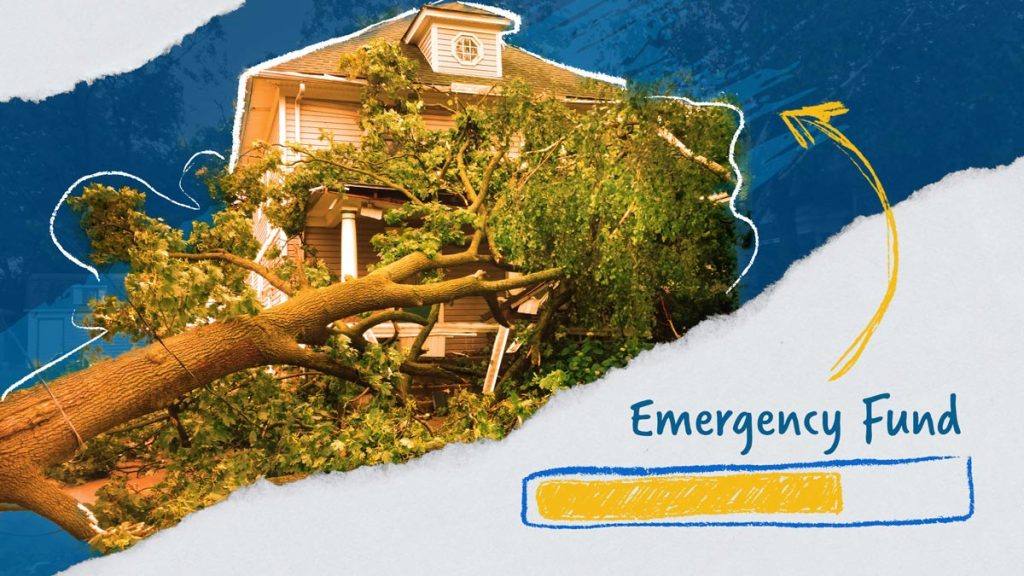Emergencies hit you out of nowhere. And if you don’t have a buffer of cash between you and all the twists and turns of life, things can get tricky fast. That’s where an emergency fund comes to the rescue—it’s your financial safety net when things go south.
An emergency fund works like a dream if you’ve got enough money saved. But what happens when the emergency is bigger than your savings? What if your kid plus a trampoline equals a trip to the ER? Or what if you wreck your car or your boss tells you your job’s been cut?
No matter what crisis you’re going through, you don’t have to panic. You can be prepared. Here’s what to do for those times your emergency fund isn’t enough to cover your emergency.
What Is an Emergency?
First off, let’s be clear about what qualifies as an emergency. A sale at your favorite department store is not an emergency. Neither is your summer vacation. Or renovating your kitchen.
Large expenses—like new tires for the car or braces for your kids—shouldn’t be emergencies either. You know these expenses are coming, so plan ahead and save up to pay cash.
True emergencies are unexpected, necessary and urgent. Rear-ending someone on the interstate, cutting yourself while chopping veggies, or suddenly getting laid off are actual emergencies. Emergency funds are for when something serious happens, not for when you just want to treat yourself. So make sure you’ve got a bona fide emergency on your hands before you decide to dip into your savings.
“A crisis becomes an inconvenience when you have an emergency fund.”
— Dave Ramsey
How Big Should My Emergency Fund Be?
Great question! Around here, we stick to the 7 Baby Steps. Baby Step 1 is to save $1,000 for your starter emergency fund. Why? Because you need a cushion to keep you from having to borrow money while you tackle Baby Step 2—paying off all debt (except your house) using the debt snowball method.
We know $1,000 won’t cover every emergency, but that’s why it’s called a starter emergency fund. Once you’ve gotten rid of all your debt, you can move on to Baby Step 3—that’s when you save 3–6 months of expenses in a fully funded emergency fund.
If you’ve already got an emergency fund (no matter how big it is), go ahead and give yourself a high five! You’re doing better than the 78% of American workers who are living paycheck to paycheck.1 But if you find yourself in a situation that your emergency fund won’t cover, there are ways to get through it without putting yourself in debt.
5 Steps to Take When an Emergency Is Bigger Than Your Emergency Fund
1. Only pay minimum payments on each debt.
In some rare situations, you’ll need to stop your debt snowball altogether and focus on the here and now. We’re talking about really big stuff like losing a job or getting ready for a baby. In those situations, the best thing to do is only make minimum payments on all your debts for a while and focus on covering your Four Walls: food, utilities, shelter and transportation. Just worry about taking care of the essentials. When life gets back to normal, you can get back to paying off your debts with gazelle intensity.
2. Negotiate the cost of your emergency.
If a family member had to go to the hospital and you’re struggling to pay the bill, call the folks in the billing department. Ask about discounts or financial aid—or get on a payment plan for medical expenses that you can cash flow over the next several months. When in doubt, ask. Just be persistent, patient and kind. And if possible, pay something up front to show you’re serious about repaying your debt. They’ll usually work with you.
Are you prepared for life’s emergencies? Learn how to get there with Financial Peace University.
And if you’re one of hundreds or thousands who are dealing with a shared crisis (like a massive layoff, a natural disaster or a government state of emergency), see if there are any local nonprofits offering financial or physical assistance (like free food, childcare, home repairs or other resources) for those affected.
3. Shop around if you can.
When your car is on the fritz, it pays to shop around. Ask friends for reliable mechanic recommendations, and then call or look online for deals, coupons and specials. Be sure the mechanic you pick gives you a quote before you agree to let them do any work. If their price is more than you can afford, ask for the bare-minimum fix that will get you back on the road safely until you can save for a bigger repair or a replacement car. If your vehicle absolutely isn’t drivable, consider carpooling or taking public transportation.
And if you need to replace an essential item (like a washer or an HVAC unit), start by browsing online. Look for sales or other discounts, and compare prices. You’d be surprised by how much money you can save with just a little bit of research.
4. Make extra money—fast!
Let’s be real: Sometimes, you just need more cash. Car repairs and new roofs aren’t cheap after all. If you need more money, start by selling everything you don’t use anymore. Clean out your closet, attic or garage. Then hop on Facebook Marketplace, eBay or another resale site to list your old bikes, iPads, DVDs, books, furniture, clothing and TVs to get some quick cash.
If you still need more money and have a little time, you may need to make some budget cuts. Can you cancel that gym membership? What about all those streaming services? Maybe you need to find ways to shrink that grocery budget. Even if it’s only in a couple of areas, those temporary cuts can add up to some big savings.
And then there’s just plain work! Look for side hustles to earn cash. Try delivering groceries or takeout, driving for Uber or Lyft, babysitting, walking dogs, or cleaning houses. You can also boost your income without ever leaving your house by doing things like freelancing, online teaching or bookkeeping. You can grow your financial safety net if you’re willing to get creative and make some sacrifices.
5. Rebuild your emergency fund.
Once the dust settles and the storm has passed, it’s time to rebuild your emergency fund as soon as possible. If there’s one thing you can count on, it’s that there will be another emergency at some point. And when that happens, you’ll be thankful you have your emergency fund to help you weather the storm. So go ahead and focus on building that savings back up!
Get Peace of Mind
Wouldn’t it be nice to not have to worry about money when things go haywire? An emergency fund is more than just a financial buffer that gets you through hard times—it also gives you peace of mind!
Look, life happens. There’s always going to be something that tries to knock you down. But when you’ve got a fully funded emergency fund in place, you’ll be prepared instead of paranoid. You’ll be like the little pig who built his house out of bricks. He wasn’t scared when the Big Bad Wolf started huffing and puffing. Having enough money in savings lets you breathe and think through your options instead of panicking and making bad decisions.
If you’re ready to stop stressing and finally feel confident with your money, you can start today with Financial Peace University (FPU). It’s a nine-week video course you can watch from home that teaches you everything you need to know about saving for emergencies, paying off debt, and investing for your future.
You can take control of your money and feel prepared for whatever life throws at you. Try FPU today!
Read the full article here
















